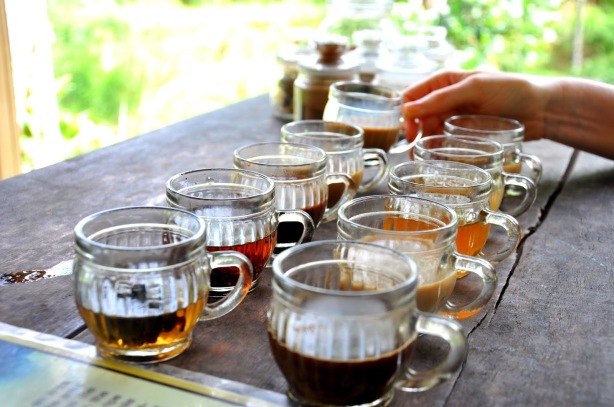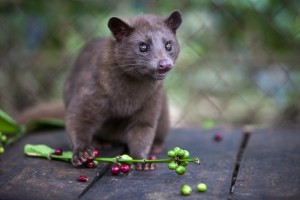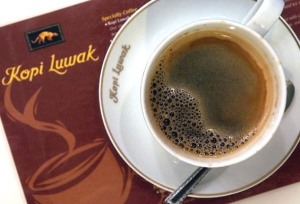If you are a coffee lovers, you may have known about Kopi Luwak before. Kopi Luwak has been one of the world most expansive varieties of Coffee for decades. Why it could be happened?, Well, before you explore our web site for further, It would be nice if we introduce you all about story of Kopi Luwak and why it is so expansive.
Indonesia is the world’s fourth largest country producing coffee, one of the island in Indonesia which is produce coffee is SUMATRA ISLAND, this Island consist of a few of province.
- Arabica Coffee much produce in a North side province of Sumatra Island, Like North Sumatra (Lintong Coffee) and Aceh ( Gayo Coffee).
- Robusta coffee are much produce in south side province of Sumatra Island are South Sumatra and Lampung.
For More than 5 decades, Sumatra Island are famous as the one of the place which is produce best coffee in this world like Mandheling Coffee, Lintong Coffee and Gayo Coffee.
Every body knows that Brazil and Colombia are the largest country producing coffee, Jamaica with the Blue Mountain and Hawaii with the Hawaii Kona, all the best coffee in the world. For more than 4 decades every coffee lovers said that what they are drinking now is the best coffee, but now it doesn’t applied anymore. Is it true?
Yes of course, to find it you have go to the Indonesia and go then to Sumatra Island, the Island which is kept the best coffee in this World.
The question could be ask about this coffee,
1. What Is the name of the coffee?
 You may say that the coffee is a Mad Coffee, Disgusting Coffee but yes, that is the best Coffee In this world named KOPI LUWAK, the coffee that produce from the Luwak digestion’s.
You may say that the coffee is a Mad Coffee, Disgusting Coffee but yes, that is the best Coffee In this world named KOPI LUWAK, the coffee that produce from the Luwak digestion’s.
2. Well, how is the taste of that kopi Luwak ?
It’s really good, heavy with a caramel taste, heavy body. It smells musty and jungle like green, have a strong chocolaty taste and also the sweet aftertaste stays in mouth that makes you want have one more sip of the coffee.
3. Why you said that coffee is the best coffee in this world? Explain it.
“Kopi” is the Indonesian word for coffee and the “Luwak” is the indigenous animal, whereas Luwak is a local name of Asia Palm Civet. Luwak are noctural omnivores utilizing fruits as a major food source and who plays an “active” role in the harvesting of the raw coffee cherries.
The Luwak feasts on ripe, red coffee cherries seeking out the sweet taste of the cherry itself, wanting little to do with the parchment of the coffee. Once the Luwak eats the cherry, the parchment covered coffee beans are passed out of the Luwak, with the parchment cover still protecting the green coffee beans. Luwak only eat the high quality coffee berries are their favorite food. The Luwak always eat the best coffee berries so its make the coffee farmers do not like the much.
Luwak like as a Bat, their only out in a night day to eat. In the night they come from forest to the coffee farm, During the night, the civet uses its eyesight and smell to seek out and eat only the ripest coffee cherries, but of course not only coffee they eat but also some of fruit like papaya, tomato, guava and etc, but major of their food is Coffee.
After gorged, luwak go back to the forest and for more than 12 hours coffee that they eaten was processed in their stomach and then they excrete it (raw of Kopi Luwak) in any where, some times if the trees, in the coffee farm and also in the bush.
The local natives/farmers gather up the limited amount of the luwak processed parchment coffee which comes through the digestion process fairly intact, still wrapped in layers of the coffee cherry mucilage and then they remove the parchment shell and ultimately ship it to the coffee broker.
4. So, what make it be the unique and best coffee?

This is the explanation,
New research explains structure, taste of Kopi Luwak coffee
When a Kopi Luwak coffee bean, the world’s most expensive coffee, comes out the other end of a large cat after it’s been eaten by the animal – called a civet or Luwak – the micro-structural properties of the beans are altered, according to new research by a University of Guelph scientist published in Food Research International .
They’re harder, more brittle and darker in colour than the same type of bean that hasn’t been eaten and digested by the three- to 10-pound tree-climbing animal found in Ethiopia and Indonesia. “The changes in the beans show that during transit through the civet’s GI track, various digestive biochemicals are actually penetrating the outer coffee cherry and reaching the actual bean surface, where a chemical colour change takes place,” said Massimo Marcone, author of “Composition and properties of Indonesian palm civet coffee (Kopi Luwak) and Ethiopian civet coffee.” Marcone is an adjunct professor in the Department of Food Science.
Marcone travelled to Ethiopia and Indonesia in 2003 to collect the rare coffee beans that cost $600 a pound. “During the night, the civet uses its eyesight and smell to seek out and eat only the ripest coffee cherries,” he said. “The coffee cherry fruit is completely digested by the Luwak, but the beans are excreted in their feces.”
The internal fermentation by digestive enzymes adds a unique flavour to the beans, which Marcone said has been described as “earthy, musty, syrupy, smooth and rich with jungle and chocolate undertones.”
“The civet beans are lower in total protein, indicating that during digestion, proteins are being broken down and are also leached out of the bean,” said Marcone. “Since proteins are what make coffee bitter during the roasting process, the lower levels of proteins decrease the bitterness of Kopi Luwak coffee.”
In the coffee industry, wet processed or fermented coffees are known to have superior flavour to dry-processed coffee, he said. “When coffee cherries are processed through the digestive track, they actually undergo a type of wet processing due to acidification in the stomach and fermentation due to the natural intestinal microflora. Lactic acid bacteria are preferred in wet processing systems. Lactic acid bacteria happen to be major colonizing bacteria in the civet’s digestive track.” The unique Kopi Luwak flavour could be due to the type of wet process the beans undergo in the animal’s digestive tracks, he said.
Quote from Communications and Public Affairs, Department of Food Science, Canada
5. So why Kopi luwak is expensive.
Luwak only eat the best quality of the coffee beries so its make the production of the kopi luwak is very limited, that’s explain why the natural Kopi Luwak is expensive. Yet, after Kopi Luwak was discovered, some coffee farmers catch the wild civets (Luwak) to breed in order to increase the production of Kopi Luwak. And of course the quality are very different from the wild one, means more bad than the wild one.
Well, how about our explanation, Interest to test it ? come on go to our shopping chart.










 offee lovers spread across the world would know the pleasure lies in distinguishing between any steeping cup of coffee available. His name is Kopi Luwak. Coffee beans are produced from animal weasel that makes its flavor quality. For more details again, I tried to invite you to know our nation’s history to know and how the process of civet coffee until the coffee beans are out of this shit hole weasel gained worldwide recognition as the most delicious coffee.
offee lovers spread across the world would know the pleasure lies in distinguishing between any steeping cup of coffee available. His name is Kopi Luwak. Coffee beans are produced from animal weasel that makes its flavor quality. For more details again, I tried to invite you to know our nation’s history to know and how the process of civet coffee until the coffee beans are out of this shit hole weasel gained worldwide recognition as the most delicious coffee.
